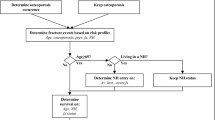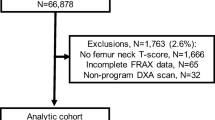Abstract
This study presents the results of a computer simulation model for calculating the cost-effectiveness and cost-utility of treating patients with established osteoporosis in order to reduce the risk of fractures. The results are based on Swedish data for risk of fracture and costs. The treatment intervention modelled is based on treatment of a 62-year-old woman with established osteoporosis. The cost per hip fracture avoided is 350000 SEK, assuming a 50% reduction in the risk of fracture due to 5 years of treatment. A sensitivity analysis for changes in the cost and effectiveness of treatment, the risk of fracture and the discount rate is performed. The cost per life-year gained and the cost per quality-adjusted life-year (QALY) gained is presented to enable comparison of the cost-effectiveness of treating osteoporosis with that of other health care interventions. A comparison between treating the same woman for osteoporosis and mild hypertension shows a cost per life-year gained of 220000 SEK and 128000 SEK respectively. Cost per QALY gained is very similar for the two interventions: 105 000 SEK and 103 000 SEK respectively. This model provides a tool to enable clinicians, administrators and health policy makers to analyze and understand the economic aspects of a major health policy issue.
Similar content being viewed by others
References
Commonwealth of Australia. Guidelines for the pharmaceutical industry in preparation of submissions to the Pharmaceutical Benefits Advisory Committee: including submissions involving economic analysis. Woden (ACT) Department of Health, Housing and Community Services, 1990.
Ontario Ministry of Health. Guidelines for preparation of economic analysis to be included in submission to the Drug Programs Branch for listing in the Ontario Drug Benefit Formulary/Comparative Drug Index. Toronto: Ministry of Health, 1991.
Kanis JA, Johnell O, Gullberg B, et al. Evidence for efficiency of drugs affecting bone metabolism in preventing hip fracture. BMJ 1992;305:1124–8.
Jönsson B, Hedbrant J, Johnell O. A computer simulation model to analyse the cost effectiveness of fracture prevention of osteoporosis. Technical description [Working paper]. Stockholm, Sweden: The Economic Research Institute, Stockholm School of Economics, 1993.
Gärdsell, et al. Predicting various fragility fractures in women by forearm bone densitometry: a follow up study. Calcif Tissue Int 1993;52:348–53.
Data on file, Center for Clinical and Basic Research, Ballerup, Denmark.
Browner WS, Seelet DG, Vogt TM, Commings SR, Non-traumatic mortality in elderly women with low bone mineral density. Lancet 1991;338:335–58
Sernbo I. Hip fracture [dissertation]. Malmö, Sweden: Lund University, Department of Orthopaedics. Malmö General Hospital, 1988.
Keene, GS, Parker MJ, Pryor GA. Mortality and morbidity after hip fractures. BMJ 1993;307:1248–50.
Hillner BE, Hollenberg JP, Pauker SG. Postmenopausal estrogens in prevention of osteoporosis: benefit virtually without risk of cardiovascular effects are considered. Am J Med 1986;80:1115–7.
Borgquist L, Lindelöw G, Thorngren K-G. Cost of hip fracture: rehabilitation of 180 patients in primary health care. Acta Orthop Scand 1991;62:39–48.
Kind P, Rosser R, Williams A. Valuation of quality of life: some psychometric evidence. In: Jones-Lee MW, editor. The value of life and safety. Amsterdam: North-Holland, 1982.
Gudex C, et al. Comparing scaling methods for health state valuations: Rosser revisited. [discussion paper 107]. York, England: University of York, Centre for Health Economics, 1993.
Johnell O, Sernbo I. Consequences of hip fracture: a prospective study over 1 year. Osteoporosis Int 1993;3:148–53.
Edebalk PG, Lindgren B, Persson U, Svensson M. Offentliga sjukhem och enskilda vårdhem: patienter, vårdassistenter och omsorgskostnader. IHE Arbetsrapport 1993:4.
Johannesson M, Borgquist L, Jönsson B. The costs of treating hypertension in Sweden. Scand J Primary Health Care 1991;9:155–60.
Fass 1993, Läkemedelsinformation 1993.
SBU Hypertoni. Report from the Swedish Council on Technology Assessment in Health Care, 1994 (forthcoming).
Tostesson ANA. A review and update of cost-effectiveness of hormone replacement therapy in the menopause. In: Cosséry J-M, editor. Medical-economic aspects of hormone replacement therapy. Parthenon Pubishing Group, 1993.
Overgaard K, Hasen MA, Jensen SB, Christiansen C. Effects of Salcatonia given intranasally on bone mass and fracture rates in established osteoporosis: a dose response study. BMJ 1992;305:556–61.
Consensus Development Conference: Diagnosis, Prophylaxis and Treatment of Osteoporosis. Am J M 1993;94:646–50.
Author information
Authors and Affiliations
Rights and permissions
About this article
Cite this article
Jönsson, B., Christiansen, C., Johnell, O. et al. Cost-effectiveness of fracture prevention in established osteoporosis. Osteoporosis Int 5, 136–142 (1995). https://doi.org/10.1007/BF01623315
Received:
Accepted:
Issue Date:
DOI: https://doi.org/10.1007/BF01623315




